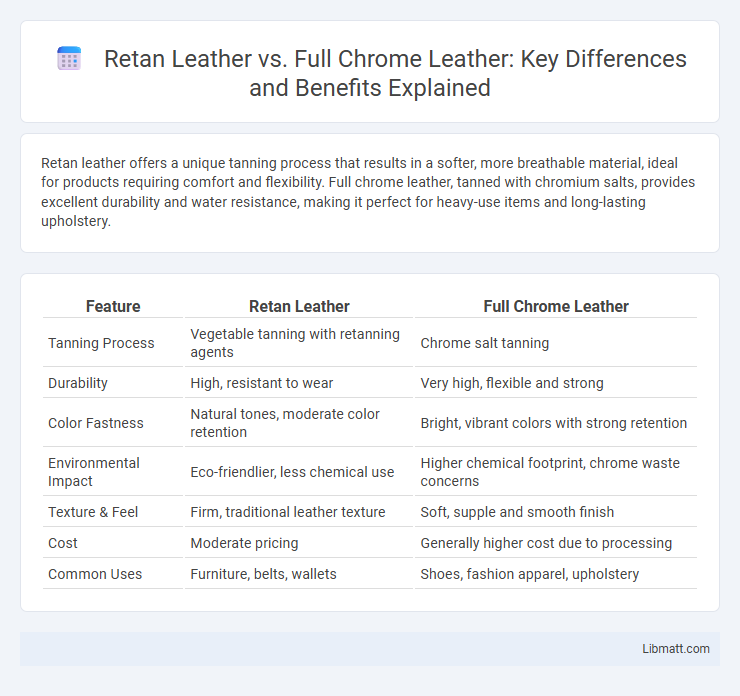Retan leather offers a unique tanning process that results in a softer, more breathable material, ideal for products requiring comfort and flexibility. Full chrome leather, tanned with chromium salts, provides excellent durability and water resistance, making it perfect for heavy-use items and long-lasting upholstery.
Table of Comparison
| Feature | Retan Leather | Full Chrome Leather |
|---|---|---|
| Tanning Process | Vegetable tanning with retanning agents | Chrome salt tanning |
| Durability | High, resistant to wear | Very high, flexible and strong |
| Color Fastness | Natural tones, moderate color retention | Bright, vibrant colors with strong retention |
| Environmental Impact | Eco-friendlier, less chemical use | Higher chemical footprint, chrome waste concerns |
| Texture & Feel | Firm, traditional leather texture | Soft, supple and smooth finish |
| Cost | Moderate pricing | Generally higher cost due to processing |
| Common Uses | Furniture, belts, wallets | Shoes, fashion apparel, upholstery |
Introduction to Retan Leather and Full Chrome Leather
Retan leather is a synthetic material designed to mimic the texture and durability of natural leather, often favored for its eco-friendly production process and water resistance. Full chrome leather undergoes a tanning process using chromium salts, resulting in a soft, supple, and durable hide with excellent color retention and resistance to wear. Your choice between Retan leather and full chrome leather depends on factors like environmental impact, durability, and aesthetic preferences.
What is Retan Leather?
Retan leather is a durable, semi-aniline leather treated with a protective coating to enhance its resistance to stains and fading, making it ideal for high-traffic applications. Unlike full chrome leather, which is fully chrome-tanned and tends to be softer with a more uniform finish, Retan leather balances natural grain visibility with improved durability. Your choice between these materials depends on the desired texture, maintenance level, and lifespan of the leather product.
Defining Full Chrome Leather
Full chrome leather is a type of leather tanned using chromium salts, resulting in a durable, water-resistant material with a consistent finish. This tanning process enhances the leather's softness and flexibility while maintaining its strength, making it ideal for furniture and automotive upholstery. Understanding the characteristics of full chrome leather helps you choose between options like retan leather based on your needs for longevity and appearance.
Tanning Processes: Retan vs. Chrome
Retan leather employs a vegetable tanning process using natural tannins from tree bark, which results in a more environmentally friendly and biodegradable material with a firmer, more breathable texture. Full chrome leather utilizes chromium salts in a chemical tanning process that accelerates production and produces softer, more water-resistant leather with enhanced durability and color retention. The choice between Retan and full chrome tanning critically impacts the leather's ecological footprint, aesthetic qualities, and functional performance.
Durability and Strength Comparison
Retan leather exhibits enhanced durability due to its unique tanning process that preserves natural fibers while providing resistance to wear and tear. Full chrome leather, treated with chromium salts, offers excellent water resistance and softness but may be less robust under heavy mechanical stress. For applications requiring superior strength and long-lasting performance, Retan leather generally outperforms full chrome leather in durability metrics.
Visual and Textural Differences
Retan leather showcases a rich, natural grain with a matte finish, offering a soft, supple texture that enhances its deep, organic appeal. Full chrome leather features a smooth, glossy surface with a uniform, polished look and a firmer, more durable feel due to extensive chrome tanning. These visual and textural contrasts highlight Retan leather's artisanal warmth versus full chrome leather's sleek modernity.
Environmental Impact and Sustainability
Retan leather production often involves vegetable tanning, which uses natural tannins from plant sources, resulting in lower environmental impact compared to full chrome leather that relies on chromium salts, known for their toxicity and pollution risks. Vegetable tanning in Retan leather is biodegradable and reduces hazardous waste, promoting sustainability in leather processing. Full chrome leather's chemical-intensive production contributes to soil and water contamination, making Retan leather a more eco-friendly and sustainable alternative.
Common Uses in the Leather Industry
Retan leather is commonly used in fashion accessories and upholstery due to its soft texture and durability, offering a premium feel for products like handbags and furniture. Full chrome leather, valued for its water resistance and smooth finish, is frequently utilized in automotive interiors, footwear, and high-end apparel. Your choice between Retan and full chrome leather depends on whether you prioritize natural softness or enhanced protection for specific leather applications.
Cost Considerations: Retan vs. Full Chrome
Retan leather offers a cost-effective alternative to full chrome leather, typically priced lower due to less intensive tanning processes and reduced chemical usage. Full chrome leather involves chromium salts, which increase production expenses but enhance durability and color retention, justifying its higher market price. Choosing between Retan and full chrome leather depends on budget constraints and the desired balance between cost and long-term performance.
How to Choose Between Retan and Full Chrome Leather
Choosing between Retan leather and full chrome leather depends on the desired durability and finish; Retan leather offers a more natural, matte appearance with higher breathability, while full chrome leather provides a glossy finish and superior water resistance due to its chrome tanning process. Consider the end use: Retan leather is ideal for products requiring flexibility and comfort, such as apparel, whereas full chrome leather suits heavy-use items like upholstery or footwear that demand enhanced toughness and stain resistance. Budget and environmental factors also play roles, as full chrome leather involves chemical processes that may impact sustainability compared to the more traditional tanning methods used for Retan leather.
Retan leather vs full chrome leather Infographic

 libmatt.com
libmatt.com